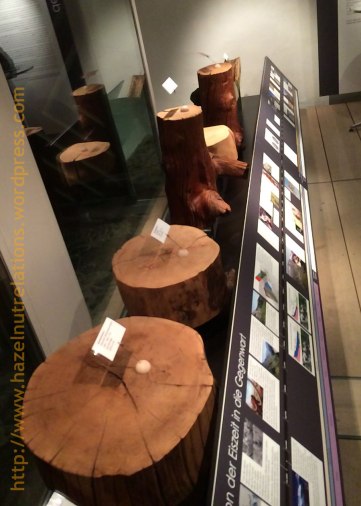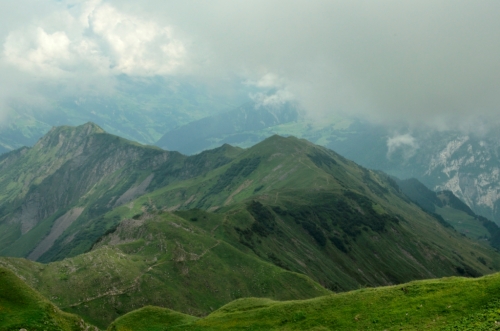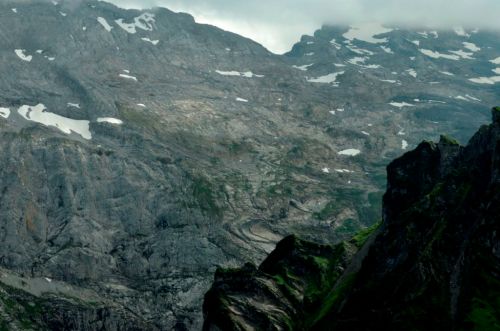«Gletscher, Wald und Steinzeitmenschen im Urschnertal»
English text below.
Sechs Jahre ist es schon her, dass ich an den archäologischen Prospektionen und Ausgrabungen im Urserntal, zwischen Andermatt und Hospental, teilnahm. Die Funde, welche v. A. aus der Römerzeit, dem Mittelalter sowie aus der Bronzezeit und dem Mesolithikum stammen, wurden vor einigen Jahren ausgewertet und publiziert. Jetzt sind diese archäologischen Funde mit der faszinierenden Wald- und Gletschergeschichte zusammen geführt worden und in einer schönen Sonderausstellung im Talmuseum Urserntal in Andermatt zu sehen.
Neben vielen Bilder, die die Wald-, Gletscher- und Kulturgeschichte illustrieren und einem eindrücklichen Tonbildschau sind viele originale Objekte ausgestellt. So gibt es erstaunlich gut erhaltene und bis zu 8000 Jahre alte fossile Baustämmen zu bestaunen. Sie sind instrumental für das Verständnis des Urserntals so wie wir es heute kennen. Zu guter Letzt ist auch eine schöne Auswahl von archäologischen Funden zu sehen, die etwa 7000 Jahre Menschheitsgeschichte im Urserental widerspiegeln.
Letzten Freitag fand die Vernissage statt, verbunden mit einem erfreulichen Wiedersehen mit alten Kollegen. Die Ausstellung ist noch bis 8. Okt. 2016 zu sehen. Die Öffnungszeiten (Mi-So 16-18:00) erlauben den Besuch nach einen schönen Tag im Schnee oder einer Wanderung im Gotthardgebiet.
Publikationen: Siehe weiter unten

Fosil woods in the exhibition “Gletscher, Wald und Steinzeitmenschen im Urscherntal” Talmuseum Urserntal, Andermatt.
It has already been six years since I took part in the archaeological survey and excavations between Andermatt and in Hospental in the Urserntal. Finds dating to roman times, the Middle Ages as well as the Bronze Age and Mesolithic, have been analysed and published some years ago. Now, these finds have been combined with the evidence for glacial- and forest histories and have been made into a special exhibition at the Talmuseum Urserntal in Andermatt.
A great number of visuals and an impressive slide/audio-show illustrate the natural and cultural history of the valley. But many original objects can be seen as well. Amazingly well preserved fossil trees dating up to 8000 years back are essential in explaining the glacial and forest histories of the Ursern valley. The valley’s 7000 year long cultural history is shown through archaeological finds spanning this long period.
Friday, the exhibition was officially opened. It is well worth a visit and for many of us it was a good opportunity to meet up with old colleagues again. The exhibition will be open until Oct. 8th 2016. And the best thing is: the opening times (16-18:00 Wed. – Sun.) mean that it is perfect for a visit after a day on the slopes or after a good hike.
Publications:
2014 “Spuren einer Kulturlandschaft. Archäologie Untersuchungen bei Hospental 2007 und 2010.” Historisches Neujahrsblatt 2013, Neue Folge 68, 1/103, pp. 37-83. ISSN: 978-3-906130-87-3
Auf der Maur, C. & Cornelissen, M., 2014, Die spätmesolithische und bronzezeitliche Fundstelle Hospental-Moos. Ein Einblick in das urgeschichtliche Urserntal, in “Spuren einer Kulturlandschaft. Archäologie Untersuchungen bei Hospental 2007 und 2010.” Historisches Neujahrsblatt 2013, Neue Folge 68, 1/103, pp. 37-83.
Spillmann, P., Labhart, T., Brücker, W., Renner, F., Gisler, C. & Zgraggen, A., 2011, Geologie des Kantons Uri. Naturforschende Gesellschaft Uri, Bericht 24, Altdorf







